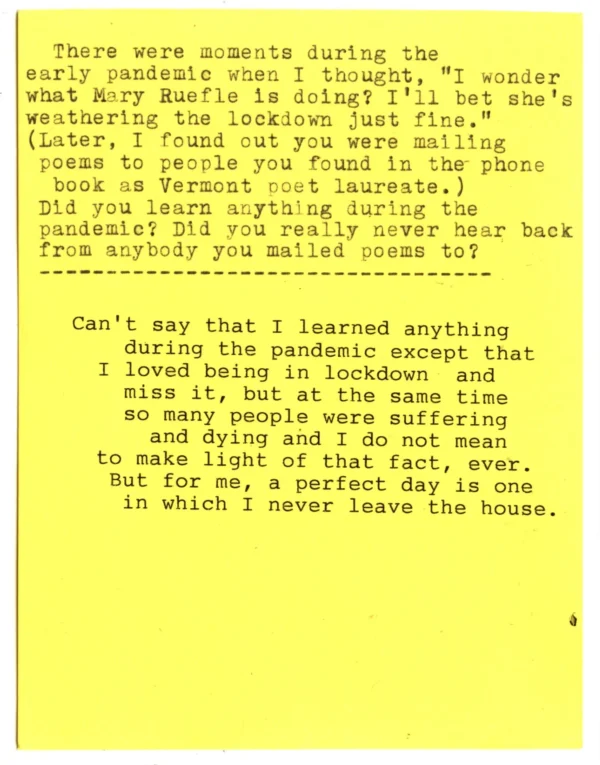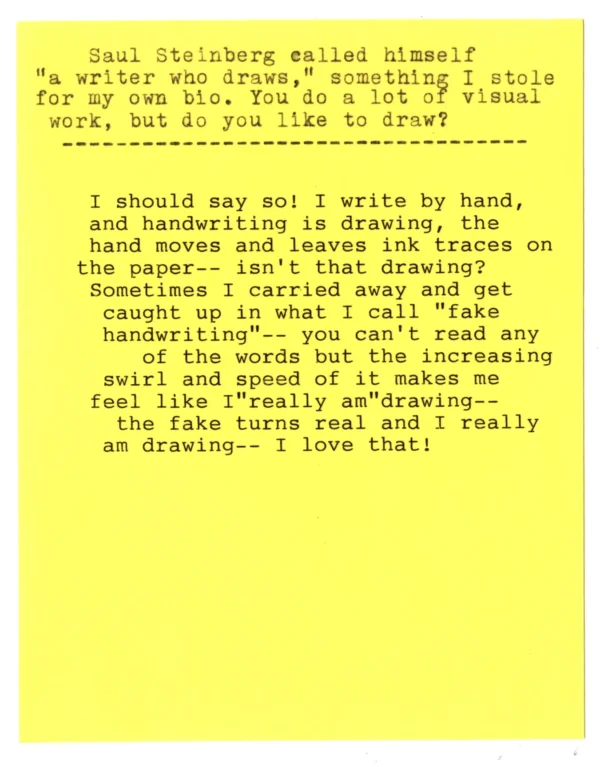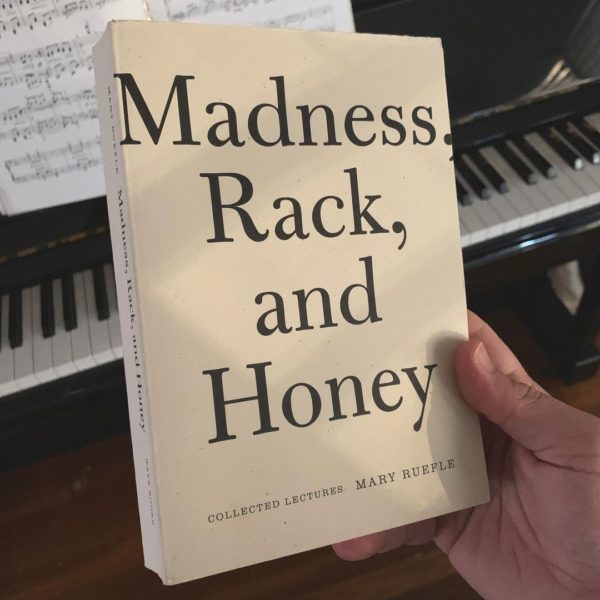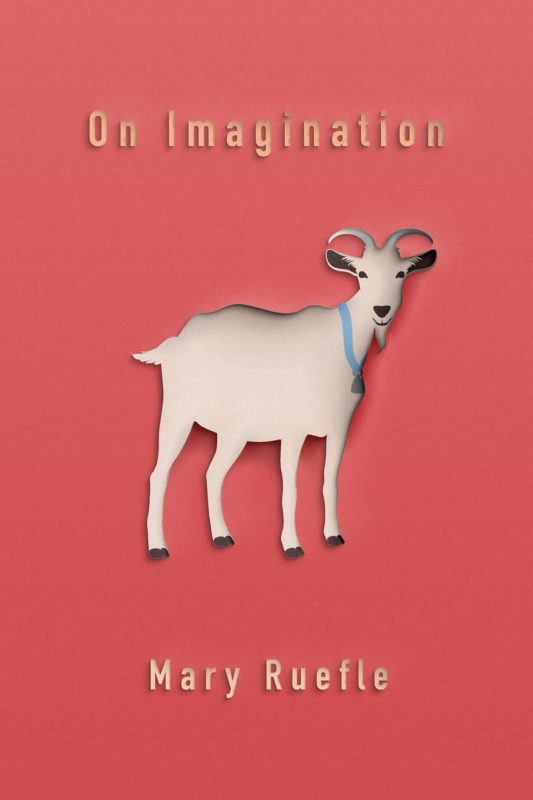A highlight of my year so far: The poet Mary Ruefle doesn’t do Zoom interviews or use a computer, so we conducted an interview via our typewriters. I typed a bunch of questions on individual pieces of yellow paper and mailed them to her home in Bennington, Vermont. She typed her answers underneath and mailed them back to me. You can read the complete interview in today’s newsletter.
Mary Ruefle’s Madness, Rack, and Honey
I wrote about Mary Ruefle’s erasure book A Little White Shadow in the history section of Newspaper Blackout, but I didn’t truly fall in love with her work until I read her collected lectures in Madness, Rack, and Honey in 2013.
As someone who tries, desperately, to write books intentionally, it humbles me to look at the bookshelf and make note of how many of my favorite books were the author’s happy accident.
“I never set out to write this book,” Ruefle says in the introduction. In 1994, she had to deliver lectures to graduate students, and rather than trying to wing it, she wrote them out first, because “writing is my natural act, more natural than speaking.”
She notes that the book becomes more “increasingly fragmentary” as it goes, and David Kirby picked up on this in his NYTimes review:
In many ways, “Madness, Rack, and Honey” reads like a steroid-boosted version of a commonplace book, those thinking persons’ scrapbooks that became popular in early modern Europe and contained quotations from the classics, scraps of conversation, poem fragments, recipes, proverbs and lists of every sort. With all of Ruefle’s borrowings and rephrasings, it’s difficult sometimes to tell exactly who’s talking, which may be the idea. One authority burrows into another, as when the painter Cy Twombly is cited as quoting the poet John Crowe Ransom’s assertion that “the image cannot be dispossessed of a primordial freshness which ideas can never claim.” I believe the rappers call this “sampling.”
I like her idea for a class called “Footnotes”:
In it, the students would read a footnoted edition of a definitive text—I thought it might as well be The Notebooks of Malte Laurids Brigge—and proceed diligently to read every book mentioned in the footnotes (or the books by those authors mentioned) an in turn all those mentioned in the footnotes of the footnoted books, and so on and so on, stopping only when one was led back, by a footnote, to The Notebooks of Malte Laurids Brigge.”
And her connection between drawing and writing:
The greatest lesson in writing I ever had was given to me in an art class. The drawing instructor took a sheet of paper and held up a pencil. She very lightly put the pencil on the piece of paper and applied a little pressure; by bringing her hand a little ways in one direction, she left a mark upon the paper. “That’s all there is to it,” she said, “but it’s a miracle. Once there was nothing, and now there’s a mark.”
Some sentences I underlined in 2013. It is fun to realize how many of these ideas I have internalized — particularly the parts about “breaking bread with the dead”:
- “if you have any idea for a poem, an exact grid of intent, you are on the wrong path”
- “dread has the word read inside of it, telling us to read carefully and find the dead, who are also there”
- “fear is overcome by procedure”
- “In one sense, reading is a great waste of time. In another sense, it is a great extension of time.”
- “I began writing because I had made friends with the dead: they had written to me, in their books, about life on earth and I wanted to write back…”
- “I do not care if I am writing a poem or a letter—it is just making marks on a sheet of paper that delights and envelops me.”
- “Poets are dead people talking about being alive.”
- “Insanity is ‘doing the same thing over and over, expecting different results.’ That’s writing poetry, but hey, it’s also getting out of bed every morning.”
- “For me, there is no difference between writing and drawing.”
- “When I make contact with a piece of paper without looking up I am happy.”
I tend to love essays written by poets — it’s interesting to me that Ruefle is hesitant about writing prose essays, because they are the thing that led me to her poetry, not the other way around.
As I said, I have since become a huge fan of her work — I love her sense of wonder, her way with images, and her sense of humor. (And her erasures, of course, which she’s as crazy about as I am.) Her last two books, My Private Property and Dunce, were at the top of my 2020 reading list.
Her writing gave me much comfort at the beginning of lockdown and she became my quarantine queen, in a sense — I figured with her penchant for solitude and self-entertainment, if anybody could make it through this it would be her.
I was not disappointed when I googled her name the other day and found out she had spent a good portion of the pandemic mailing poems to Vermonters whose names she found in the phone book.
* * *
Every Saturday weekend I put one of my favorite books on the Bookshelf. To see more of my favorite books, check out my reading years.
To wonder rather than know
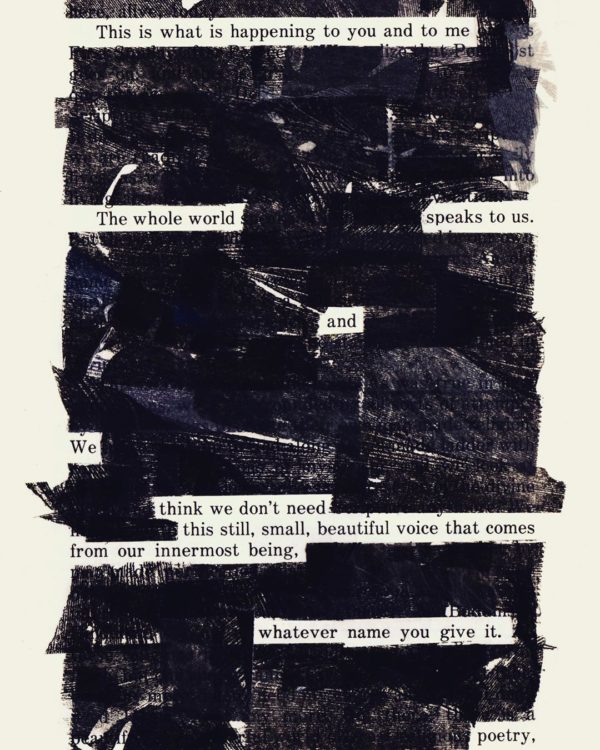
Mary Ruefle, in a wonderful conversation with David Naimon:
I would rather wonder than know. It makes it more and more difficult to be alive on earth in these times, when your inclination is to wonder rather than to know.
I suppose the example that comes to mind is: it used to be if you were having dinner with people and someone said, “Who’s the fastest animal on earth?” An amazing conversation would ensue. And now someone pops their phone out and looks up the answer. And it breaks my heart….
I really, really don’t like it when people look things up on their iPhones…. I mean, sometimes, of course, I’m no idiot. The encyclopedic nature of the information that’s available is fantastic, but I would still rather wonder than know.
I think wondering is a way of inhabiting and lingering. There seems to be more dwelling. To dwell, inhabit, and linger. I’m interested in those things. And you can do that when you don’t know.
We tend to, as human beings, our impulse is, once we know, once we have the answer, we move on. So we’re constantly moving from one thing to the other. I would rather inhabit the question, or dwell. For me, that is the place I want to live in.
I have an encyclopedia at home. It never occurred to me there was ever anything wrong with it until my friend pointed out it was an Encyclopedia Brittanica from 1910 and it might be a little outdated. I still look things up in it! […]
My oldest son used to ask me questions and when I said I didn’t know the answer, he’d say, “Look it up on the Goggle!” It takes discipline, now, not to look things up immediately, but to sit and wonder…
Then again, when you do look things up, you find more things to wonder about.
Mary Ruefle on the joy of blackout poetry
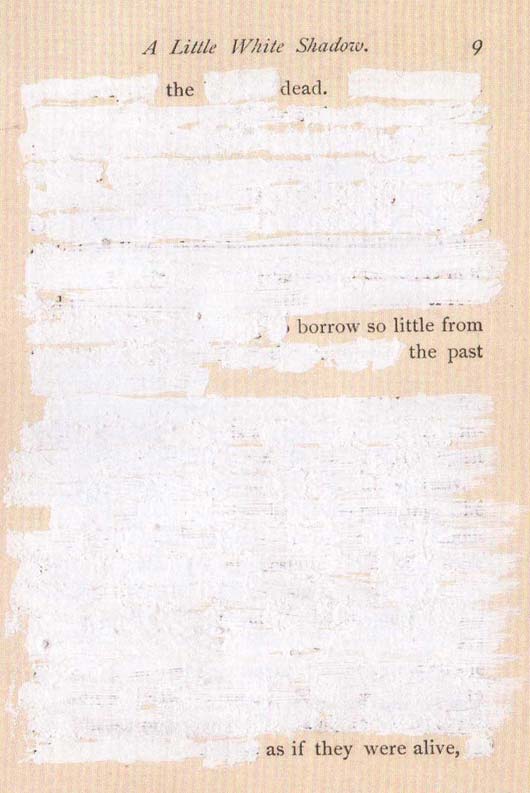
I love, love, love this part of Mary Ruefle’s long conversation with Ron Charles when she talks about A Little White Shadow and how she makes her erasure poems. (Basically the White Out version of blackout poetry.)
Here’s how she says she gets started:
All the words rise up and they hover a quarter inch above the page. It’s like a field, and they’re hovering. I don’t actually read the page. I read the words, which is different. So I’m looking, and I see all the words. And I go in and I pick a phrase or a word that’s delicious that I really love.
On how much she loves doing them:
I find it meditative and I find it infuriating sometimes and challenging and I like the smell of the White Out — dreadfully toxic! Really toxic…. I love it. Oh, I love it so much. There is nothing like it on Earth. I’m crazy about it.
Despite the haters:
A lot of people hate them… I’ve talked to people who just, “Why do you waste your time doing that?” Because it’s fun and I love it. That’s why.
The whole interview is wonderful and worth watching. Love her:
Images in the head
“Imagination is when you close your eyes and think of a door.”
—Dave Hickey
Yesterday I read Mary Ruefle’s chapbook, On Imagination, in which she writes, “Anything involving an image in the head is an act of imagination.”
The imagination — the ability to make images in your head that aren’t right in front of your eyeballs — seems to me such a crucial human tool that I find myself resenting people who don’t seem to possess much of one. It’s one of the reasons I shout at the television every time a guest on House Hunters whines, “I don’t like the carpet.” (A lack of imagination will cost you — especially in real estate.)
The other day on my walk I was rushed by an off-leash pitbull. “He’s friendly!” his owner shouted, like they always do. I usually curse off-leash dog owners as stupid or entitled or whatever, but on that particular day I wondered: Do people who let their dogs off-leash simply lack an imagination? Or do they simply refuse to use it when it comes to their beloved pets? This makes much more sense to me: that they simply cannot or will not picture in their minds the worst happening.
Me, on the other hand, I spend all day thinking about the worst that can happen. “Fear comes with imagination,” writes Thomas Harris in Red Dragon. “It’s a penalty, it’s the price of imagination.”
(I fear, now, that I plagiarized him in Show Your Work!: “The trouble with imaginative people is that we’re good at picturing the worst that could happen to us. Fear is often just the imagination taking a wrong turn.”)
This is an idea at the heart of Ruefle’s essay. She says it “irks” her when artists speak of the imagination as only a benevolent tool, “as if there were nothing pejorative or destructive about it.” On the contrary, she writes, “the imagination is a full, rounded, complex thing.” She calls the imagination her “daimon” because it is “my best friend and my worst enemy.”
Something that stopped me in my (admittedly) prejudiced tracks a few years ago was the discovery that there are literally people who cannot think in pictures. It’s called “congenital aphantasia.” Researchers estimate that 2-5% of the population are “non-imagers,” or “mind blind.” Here are a few non-imager testimonials:
“Part of me still believes that when people say they’re ‘picturing’ something, they mean it metaphorically, like I do,” says Kelly Sandoval, a fiction writer from Seattle who is a natural non-imager. “To me, seeing images in your head sounds like a superpower.”
“It’s kind of like learning your best friend can move objects with his mind,” agrees Bruno Ferreira from Rio de Janeiro. Having no personal experience of thinking in pictures, non-imagers often grow up seeing references to mental imagery as simple figures of speech.
(It’s interesting to me that this is the exact opposite of Temple Grandin, who writes about her autism and visualization abilities in her memoir, Thinking In Pictures, “When I was a child and a teenager, I thought everybody thought in pictures.”)
Is there a silver lining to not being able to make images in your head? According to Kelly Sandoval, “Not picturing things means that when I write, it’s fairly easy to get the words down.”
If she could teach the world just one thing about being a non-imager, it’s that “it’s not a lack of imagination. You don’t need pictures in your head to be creative. You just need ideas. And ideas come in all sorts of forms.”
In fact, the imagination need not be limited to pictures. In his essay, “The Reach of Imagination,” Jacob Bronowski writes, “To imagine means to make images and to move them about inside one’s head in new arrangements.” But, “I am using the word image in a wide meaning, which does not restrict it to the mind’s eye as a visual organ.” In his usage, “image” includes signs, and, oh hey, words: “the most important images for human beings are simply words, which are abstract symbols.”
So, basically, as Sandoval noted: Just because you can’t see pictures in your head doesn’t mean you don’t have an imagination.
Oh, also: Not being able to make pictures in your head might help you avoid the bad stuff that comes with along with the skill (in his essay, “Of the Force of Imagination,” Montaigne said that he made it his business to avoid and resist his imagination!):
Overactive visual imagery is thought to play a role in addiction and cravings, as well as the development of anxiety disorders such as PTSD. It may be that the inability to visualise might anchor people in the present and allow them to live more fully in the moment.
Oddly, this one of the last points of Ruefle’s essay. She feels like she’s not as good of a teacher as she used to be, because she’s older now, further away from the age of her students, and she simply doesn’t care about the same things that they do.
One way to look at it is to say they are interested in the future, and, having a very difficult and limited kind of future, I am not much interested in it, while at the same time I am more and more interested in the present moment, and I don’t mean the general state of affairs this month, I mean the bug walking across my lettuce leaf.
For those of us who are still interested and invested, we’ll need our imaginations, in whatever form they take.
“One idea about the imagination is that it is the agency of our soul which creates the future,” says Lewis Hyde. “It allows us to call into being worlds that don’t yet exist.”
To create a future, we need better imaginations, and for better imaginations, we need to feed them better ideas and better images.
